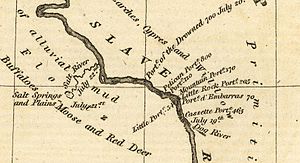François Beaulieu II facts for kids
Quick facts for kids
François Beaulieu II
|
|
|---|---|
| Born | 1771 Northwest Territories, Canada
|
| Died | November 1872 Salt River, Northwest Territories, Canada
|
| Occupation | Metis leader, chief, interpreter, guide |
François Beaulieu II (born 1771 – died November 1872) was an important leader of the Yellowknife people. He was also a skilled guide and interpreter in the Arctic regions of Canada. He helped many explorers learn about the vast Northwest Territories.
Contents
A Skilled Guide and Leader
François Beaulieu II was a Métis man. His father was François Beaulieu, and his mother, Ethiba, was of Chipewyan and Cree background.
Helping Arctic Explorers
When he was a young man, Beaulieu was known for his amazing knowledge of the land. In 1793, he joined Sir Alexander Mackenzie on a long trip to the Pacific Ocean.
Later, in 1820, he met the famous Arctic explorer, John Franklin. Beaulieu gave Franklin very helpful information. He suggested a good base camp on the Dease Arm of Great Bear Lake. This was for Franklin's plan to explore the mouth of the Coppermine River.
Beaulieu also worked as a guide and interpreter on Franklin's second expedition from 1825 to 1827. This trip was based at Fort Franklin on the west side of Great Bear Lake. Beaulieu's knowledge and advice were key to making this trip one of the most successful Arctic explorations in Canada.
Chief of the Yellowknives
Beaulieu was also a respected chief of his own Yellowknife people. He was known for being a strong leader. He and his followers settled near the Salt River. Here, he traded salt with the Hudson's Bay Company. This company even gave him a special right to be the only one to trade salt from that river.
Beaulieu stayed active his whole life. He was still hunting at 85 years old! He lived to be over 100 years old. He was also the brother-in-law of another Yellowknife chief, Akaitcho. Beaulieu became chief after Akaitcho. He passed away at the Salt River settlement in November 1872.
Life at Salt River

In his book En route pour la mer Glaciale, Emile Petitot wrote about visiting François Beaulieu in 1862. This was at Salt River, near Fort Smith.
Petitot described the Salt River as a place where salt naturally collects on the shore. This salt was gathered and sent to many forts and missions in the north. Beaulieu was the one who discovered this river. He had a nice farm there where he lived with his children.
Beaulieu had seen many important events in the north. His father was a French coureur de bois (a fur trader who traveled widely). His mother was a Chipewyan woman. Beaulieu saw the first explorer of Great Slave Lake, Peter Pond, in 1780. Then, in 1789, he saw Sir Alexander Mackenzie. Beaulieu himself helped another Mackenzie, a professional hunter, at Great Bear Lake when he was 18. Later, in 1825, he was the interpreter for Sir John Franklin.
Beaulieu was a very important person in his community. He had a comfortable life from trading salt, farming, raising cows, fishing, and hunting. He also traded furs.
When Petitot met Beaulieu in 1862, Beaulieu was 85 years old. Even then, he still hunted by himself and traveled long distances with his dogs. He died a few days after his 101st birthday.
Personal Life and Faith
In 1848, when he was around 80 years old, François Beaulieu was baptized by Father Alexandre-Antonin Taché. He became a strong follower of the Roman Catholic faith. After this, he worked hard to share the Catholic faith with others.

